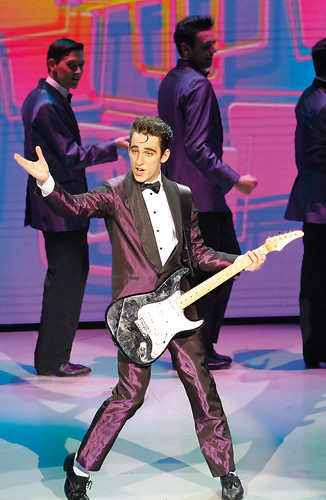
He talks about how he got the role, how he found the rehearsal process reuniting with Jason Coleman and how he's enjoying the show's run in Melbourne.
Hard and colour, formal and informal, serious and light-hearted - news and opinion

 From candlelight to gaslight to electric lighting, for centuries street lights have played a key role in keeping our suburbs safe and navigable through the night.
From candlelight to gaslight to electric lighting, for centuries street lights have played a key role in keeping our suburbs safe and navigable through the night.
For those who commute daily via train the following scenes will be of no shock, and even for those no longer punished by our long-suffering transport systems these scenes may be part of a recurring nightmare.
You’re sitting in a big, rattling tin can- also known as an old train. It feels like you’re in a sauna, except sweat dripping from your every pore like a fountain is making a sticky pool on plastic-not wooden- seats that you consequently feel glued to. Perhaps the half eaten chocolate bar from last night wedged between the seat joining is melting so you are getting an attractive-looking poo stain on your freshly ironed pants or skirt.
The lights above your head flicker on an off intermittently so hopefully you’re not trying to better endure this train ride by reading a good book. Chances are, though, you are so tightly pressed between people that you can barely move your arms. Perhaps your nose is stuck up someone’s armpit and you are holding your breath. Alternatively, your shoulder may already be invaded by someone nodding off or passing out from all the heat and therefore leaning on you like a five year old. If you were lucky enough to get a window seat you may also be consciously trying to avoid resting your own weary head on the slimy, dandruff-covered windows.
As if travelling in packed, sluggishly slow trains on a daily basis isn’t bad enough, when you add over 40 degree heat to the equation-without airconditioning- the stakes get even higher.
Sydneysiders last week suffered a record-breaking heatwave. So record-breaking Sydney has never seen temperatures over 30 degrees for seven days running in the 152 years the Bureau of Meteorology have kept weather records.
Even though the southerly cold front that swept across Sydney Sunday afternoon was a welcome cool change, the heatwave has left many commuters hot under the collar about the state’s public transport system.
As a Sydneysider myself, I commute daily via train on the East Hills/Airport line. Last week I kept a diary of the outside temperature and air-conditioning status of each trip.
Out of the ten trains I caught, predominantly in peak hour, eight of them were unairconditioned. The temperature over the week ranged from 42 to 35 degrees, which means temperatures inside the train- which traps the heat due to the tiny windows that offer very little air flow- would have been significantly higher.
I thought I may have been extremely unlucky to catch all the old trains, or maybe CityRail wanted to start interstate and international travellers’ experience in Sydney off with an unforgettable train journey- for all the wrong reasons.
According to a spokeswoman from RailCorp, 71 per cent of the CityRail fleet is currently airconditioned, of which the trains are “distributed” across the network.
Using these statistics, I had a 29 per cent chance of getting an unairconditioned train and happened to get one 80 per cent of the time. Unlucky.
The spokeswoman also said CityRail staff handed out water bottles at “a number of major train stations to help keep passengers hydrated and cool”. I never got one of those water bottles. Unlucky again.
Throughout this experience the most unpleasant thing- besides watching babies wailing because the heat was so debilitating, uncomfortable heavily pregnant women counting down the seconds till they could escape, or the elderly slumped over their seat in exhaustion- was knowing our State government harps on about Sydney as a “global city” and yet our transport system is almost medieval.
Taxpayer dollars continually go into improving these services and transport projects are frequently announced in a flourish. Then, plans either die a quick death or seem indefinitely pushed back until after the next election.
If all went to plan with the Waratah project that promised 78 new eight carriage trains to ensure the whole CityRail fleet is airconditioned, we wouldn’t even be having this conversation. The project was signed with the NSW government in 2006 and the first train set was scheduled for delivery in April last year. It has since been delayed by up to 14 months and is not due until late May or early June.
Beyond the question of airconditioning, associate professor in Transport Management at the University of Sydney, Stephen Greaves, believes the government should be looking to fix more fundamental issues such as services running on time and cutting the extraordinarily long travel times.
“If people weren’t stuck on slow, cramped trains for so long maybe they wouldn’t fuss so much,” professor Greaves said.
“It takes hours to get to the Blue Mountains or the south coast when if you were in London you would be there in 40 minutes.”
“So much money is spent maintaining the rail service when we could do things with bus networks like bus rapit transit (BRT) that’s a lot cheaper; things that would cost millions not billions.”
Every transport system around the world has its problems but it’d be nice to think this will be the last summer commuters will ever need to sweat it out on trains.
An edited version of this post was published on On Line Opinion here: http://www.onlineopinion.com.au/view.asp?article=11641